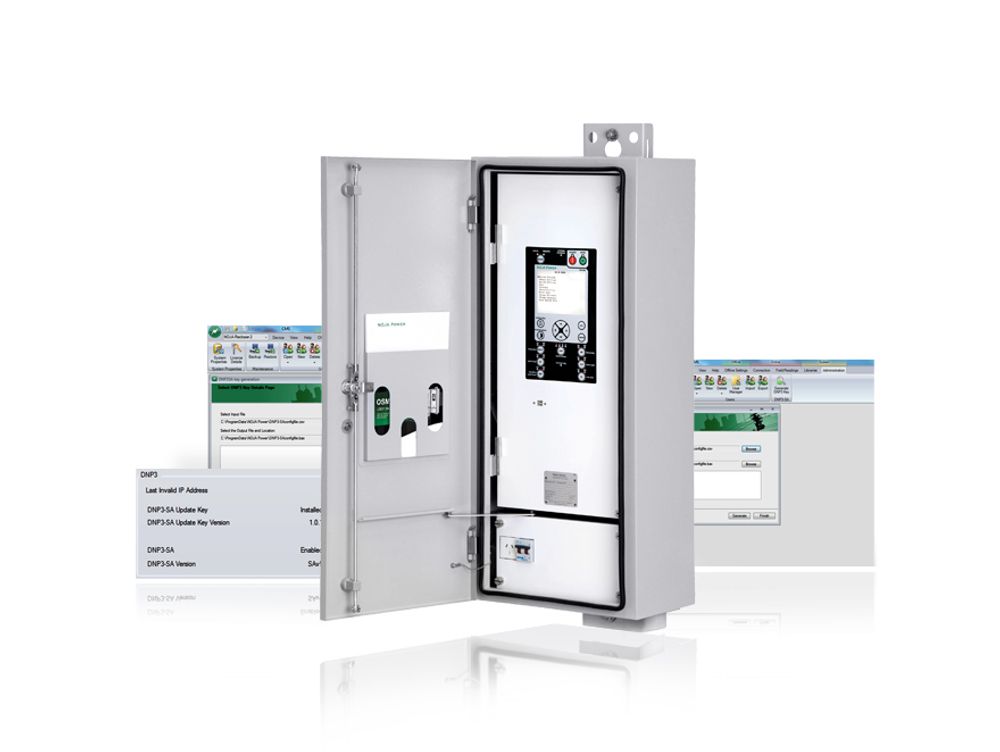Press Release
Published 03/2015
DNP3 User Group and NOJA Power demonstrate DNP3-SAv5 interoperability and security at DistribuTECH 2015
Latest version of industry-standard protocol enhances smart grid communications while helping protect against cyber security weaknesses

Electrical switchgear engineers NOJA Power today announces successful participation in a demonstration of its RC-10 control and communication cubicle (for the company’s OSM series Automatic Circuit Reclosers (“auto-recloser” or ACR)) communicating with other manufacturers’ Intelligent Electronic Devices (IED) by using an industry-standard protocol.
The demonstration, which took place on the Distributed Network Protocol (DNP) User Group’s booth at DistribuTECH 2015, showed how DNP-Secure Authentication version 5 (SAv5) operates as a secure, interoperable communication protocol for smart grid applications. The demonstration comprised a Triangle MicroWorks test harness operating as a control centre communicating with NOJA Power’s RC-10 controller and IEDs from other vendors using the DNP3-SAv5 protocol.
DNP3 already plays a crucial role as a reliable protocol for supervisory control and data acquisition (SCADA) systems––such as SCADA master stations, Remote Terminal Units (RTU) and IEDs––employed to monitor and control contemporary grids. The demonstration highlighted the interoperability and security of DNP3-SAv5, a version of the DNP3 protocol with features designed to protect smart grids––computerized, bidirectional, interactive electricity distribution networks––from cyber attacks.
Such threats are of increasing concern to governments as the Internet connectivity of smart grids could leave them vulnerable to strikes by malevolent entities. A report [1] conducted by California State University for the California Energy Commission, for example, concluded that smart grids were increasingly vulnerable to cyber security issues such as confidentiality of user information, integrity of demand response systems, integrity and availability of SCADA systems, and integrity and availability of Plug‐In Electric Vehicles. The report suggested that smart grids should be designed with measures to counter these vulnerabilities.
Since introduction, NOJA Power’s RC-10 controller has supported DNP3, and the latest generation of the product supports DNP3-SA version 2 (v2) and DNP3-SAv5. DNP3-SA defines a security architecture that uniquely identifies devices or multiple individual “users” of a device, provides for separate update keys for each device or user and supports encryption. An update introduced in DNP3-SAv5 supports symmetric or asymmetric public key infrastructure mechanisms.
The RC-10 supports Ethernet (TCP/IP and UPD/IP), an RS232 RTU interface and 3 x USB ports offer 300-19.2 k baud serial ports with full- and half-duplex modes to connect to remote control systems and DNP3 is provided as standard using any of these interfaces. The RC-10 can be configured as a field device for normal DNP3 communication with a single DNP3 master station using either a serial channel or an Ethernet network. Alternatively, several master stations can communicate with a single RC-10 providing that the master stations coordinate so that connections appear to originate from a single unit.
“We were keen to take part in the DistribuTECH 2012 DNP3-SAv5 interoperability demonstration to show that NOJA Power’s auto-reclosers fully support the protocol,” says Neil O’Sullivan, NOJA Power’s Managing Director. “We see a growing base of users advocating and deploying DNP3-SA which they consider is a more practical alternative for smart grid applications than other protocols such as IEC 61850.”
“Because our auto-reclosers form an essential element of smart grids we included support for DNP3 from the very first model and have updated the products as the protocol evolved. Such functionality puts the ‘smart’ in smart grids by ensuring individual IEDs can communicate with other units in a secure and reliable way to optimize grid performance.”
The DNP Users Group is a U.S.-based, non-profit organization with the primary purpose of maintaining and promoting DNP3. DistribuTECH is a U.S.-based, international exhibition and conference for suppliers of products and services for electricity distribution grids.
References
1. “Smart Grid Cyber Security, Potential Threats, Vulnerabilities and Risks,” California State University Sacramento, May 2012.
About DNP3
The Institute of Electrical and Electronic Engineers (IEEE), formally adopted DNP3 in July 2010, defining the protocol in IEEE 1815-2010 (“IEEE Standard for Electric Power Systems Communications - Distributed Network Protocol (DNP3)”). DNP3 already plays a crucial role in supervisory control and data acquisition (SCADA) systems employed to monitor and control contemporary grids where it is used by SCADA master stations (or Control Centers), Remote Terminal Units (RTU) and Intelligent Electronic Devices (IED). The protocol was designed with an emphasis on security and reliability making it a natural choice for smart grids.
In particular, DNP3 addresses utilities’ concerns that grids’ reliance on Internet Protocol (IP) technology for communication makes it possible for third parties to access the physical networks and underlying IP infrastructure — including hackers and other malevolent forces that might wish to disrupt control systems to disable critical infrastructure. DNP3-SA provides authentication, authorization and accounting to limit access for unauthorised personnel and their ability to negatively impact networks.
Want to stay up to date with Electrical Distribution Technology?
Join our list for a free weekly technical bulletin, as we share our Global Electrical Engineering experience directly to your inbox.
Subscribe →